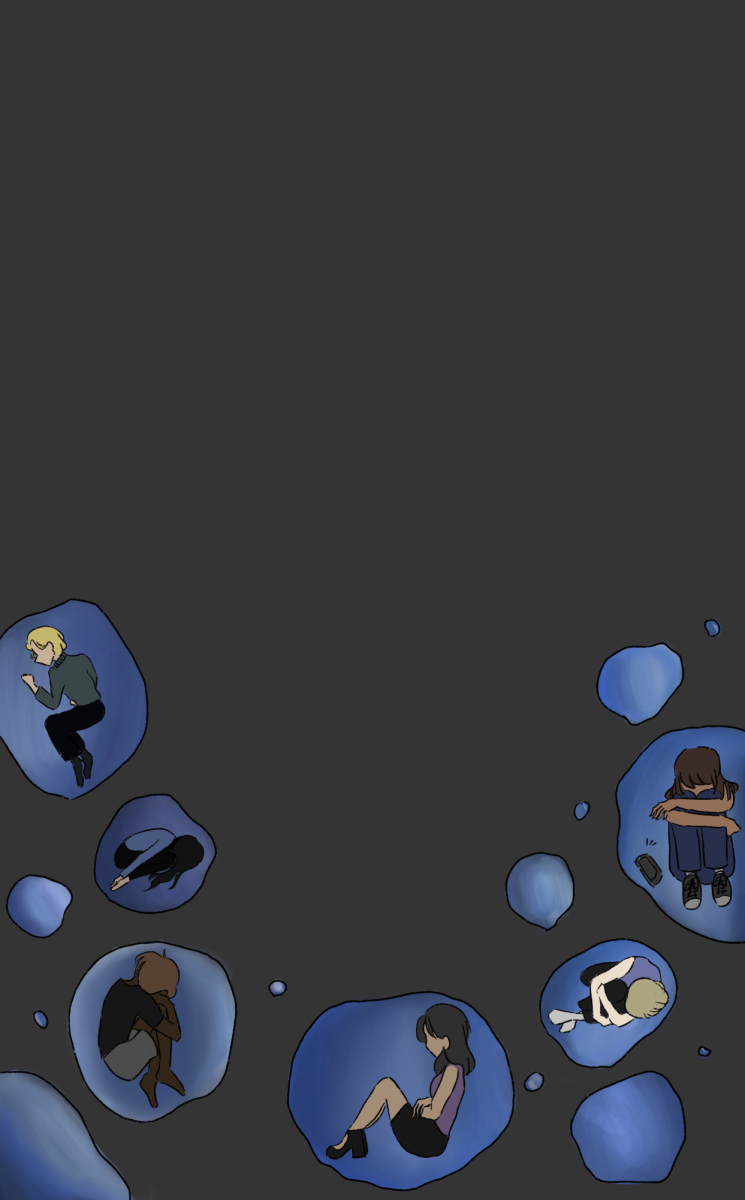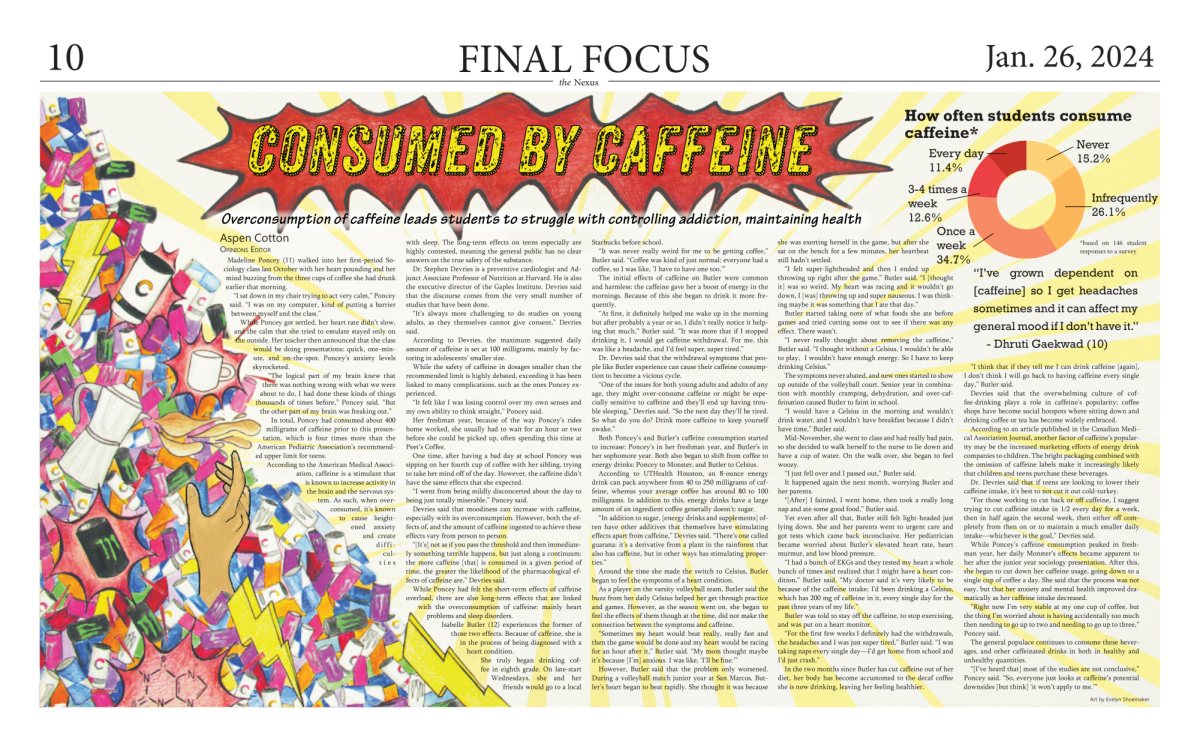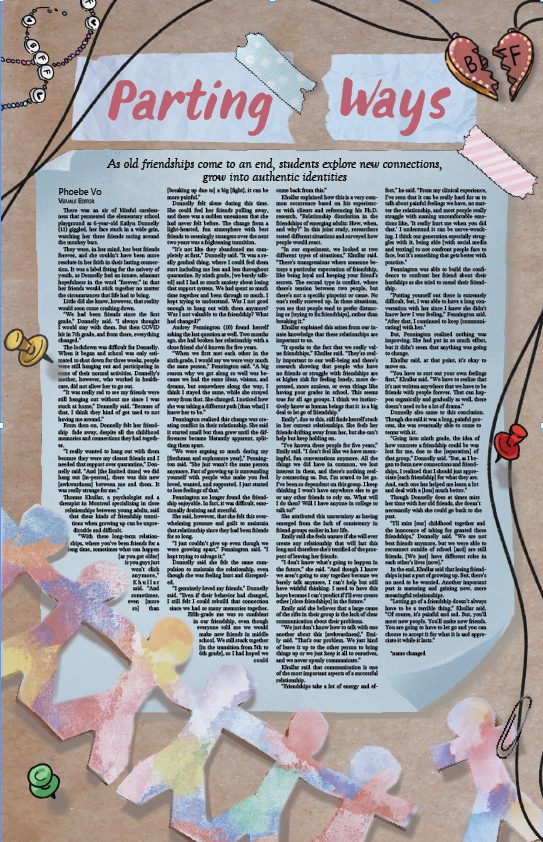When students drown in work, their stress morphs into an
unhealthy obsession that cripples their ability to function
That week of her sophomore year, whether Nandini Rajgopal (12) was in the bathroom or her room, she cried.
She cried because her grades were slipping. Because she felt she was performing poorly on the soccer team. Because her friend group split.
That week, everything seemed to be falling apart.
“I kept [the stress] all bottled in,” Rajgopal recalled. “I didn’t tell anybody. I thought that these were my problems, and I should be able to handle them. I should be able to fix them and keep going.”
Rajgopal is not alone.
According to the 2016-2017 California Healthy Kids Survey (CHKS), 20 percent of freshmen and 31 percent of juniors at Westview reported to have “felt so sad or hopeless almost every day for two weeks or more, that they stopped doing some usual activities.”
This means that at least 88 freshmen and 118 juniors at some point that year felt the same despair that Rajgopal did.
How Academic Stress Arises
Rajgopal stays busy. She sings for the advanced chamber choir, the choir program’s Soul Singers, the Southern California Regional Honor Choir, and the All-State Honor Choir. She plays on the varsity soccer team. She is also a Unity Day facilitator and president of the South-Asian Culture Show (SACS). Through the fall, Rajgopal worked on her 14 college applications.
Between school and her extracurriculars, Rajgopal said she often assumes the persona of a leapfrog, jumping from one thing to the other. Quick-changes: that’s her middle name.
“I remember running from a dance performance to a soccer game,” Rajgopal said. “I had the heavy jewelry on and had to change into my soccer jersey in the car. Even now I still have conflicts. Senior Night for soccer is the same day as the FACE ambassadors’ ceremony. I’m going to be out of town because I’m going to be in San Jose for All-State Honor Choir.”
In the shuffle of teens’ schedules, Noelle Leonard, senior research scientist at the New York University College of Nursing (NYUCN), said that teens can get absorbed in their work because of how invested they are in their studies and activities. Based on her study on “the coping skills, academic engagement, family involvement and expectations, mental health symptoms, and substance use” among juniors in two private high schools in the Northeast, she learned that when a student’s academic sphere get overwhelmingly large, their school weekday can seem to follow a routine, emotionally draining schedule.
“School, homework, extracurricular activities, sleep, repeat—that’s what it can be for some of these students,” Leonard said.
To be driven shouldn’t be frowned upon, but when a student is consumed in stress, and their mental and physical health begin to deteriorate at a faster rate than what is normal—that’s where the line should be drawn. Annie Fox, author of Too Stressed to Think?, emphasized the toxicity in teen obsession with the academic spheres of their lives, a major source of stress for teens.
“The reptilian part of our brains [is] on alert for danger,” Fox said. “If we are stressed out all the time, it’s almost as if we fooled ourselves into thinking that everything is a potential danger.”
For those who don’t overload their plates, towards their peers who are taking a certain number of APs or who are involved in a variety of extracurriculars. Those students wonder if they are doing enough. On the other end, students can feel a sense of disappointment in wondering if they’re working up to par in all their extracurriculars. After all, they’re being pulled in several directions.
“That’s the [number] one reason when I surveyed my AVID students,” social science, English, and AVID teacher, Andrea Champoux said. “What is one of your top stressors? It’s the competition between each other, which is unfortunate.”
In turn, many students’ motivation stems from the fear to do better and to keep pushing the boundaries on what is enough; enough to proudly walk through the halls with your classes, accomplishments, and extracurriculars on your sleeve. The social ramifications of high school bring another set of stresses entirely.
When all these pressures got overwhelming, Rajgopal initially didn’t give herself any excuses. The CHKS reported that 82 percent of Westview’s freshmen parents and 81 percent of junior parents graduated from a four-year college. So why should Rajgopal not aim to do the same, especially when others have their struggles too?
“I always have lived by the policy of no judgement,” Rajgopal said. “I think I was judging myself, and holding myself to a higher standard.”
Brian Wang (12) also had high expectations for himself. Seeing that his peers loaded up on advanced classes, he took AP Music Theory and AP Calculus AB his freshman year. He played for the freshman football team and the varsity tennis team, and played piano. When the year drew to a close, he knew he made a mistake in taking on too much.
“It was a matter of me trying to prove to the world that it was doable,” Wang recalled. “Freshman year was composed of late nights, studying super hard, and still learning how to procrastinate well. I didn’t want to repeat it again through sophomore, junior, or senior year.”
When focusing on one sphere over others such as academics over family or friends, one can develop “tunnel-vision.” According to Fox, a series of “stress traps,” like avoidance, procrastination, or worries can exacerbate a mental block where “your brain seems to narrow.” What can be worse is when the focus morphs into an obsession, as it did for Nasser throughout most of her high school career.
“I used to feel like if I spent even 10 minutes chilling, then I’m only thinking about [work],” Nasser said. “It got too stressful and I was crying on and off. I just got used to dealing with the same thing over and over again.”
As senior year has become a time of reflection for Wang, he’s realized that there’s a distinction between being “on a roll” and being obsessed. In learning that difference, he knows that when he needs to take a break from his work, he needs to unwind or change activities.
“Being on a roll, you are pumping out words and you are thinking that this is good stuff,” Wang explained when talking about essay-writing. “Being obsessed, your eyes are glued to the computer screen. You are typing at one word per minute, but you can’t take your mind off the idea that you need to get this done.”
Academic Stress Invading One’s Personal Spheres
When people fall into one or multiple stress traps, Fox explained how people’s “blinders” can go up, where the other spheres in students’ lives can get pushed out of their mental peripherals.
“There are psychological risks when you get so stressed out that you can’t even step outside, look up at the sky, and take a breath of fresh air,” Fox said.
With Wang, the decision to load up on APs along with a variety of time-consuming extracurriculars bore an emotional weight. Ironically, while he spent some time with teammates or friends from his extracurriculars, Wang spent most of his time his freshman year in his room.
“There was a portion of time where when I was down, I would compartmentalize everything and close myself off,” Wang recounted. “It was tough.”
On the days when Wang, Rajgopal, and Rehana Nasser (12) holed themselves up in their rooms, they kept their stresses pent up within themselves as they brewed. Sure, eventually they hit that threshold where they knew they had to make changes—for Wang that was the end of freshman year, for Rajgopal, after the Sophomore Thesis, and for Nasser, after the college application filing period passed. But the time that lead up to their forms of epiphanies consisted of isolation and episodes of sadness. As Wang, Rajgopal, and Nasser sit in their rooms, Fox said all the other spheres in their lives and its parts whiz by—friends, family, parties, or simply opportunities to relax and take a breather.
“We don’t make the best friends, the best sons or daughters, the best siblings, or the best partners in a romantic relationship,” Fox said. “We are just too wound up; too on edge.”
During their underclassmen years, when they had a tough day at school, Rajgopal and Wang sought refuge in their rooms. Once they entered through the door, the mask came off, and the stress was visible on their faces.
“When you are at home, you’re not putting up an image,” Rajgopal said. “You don’t have to put up anything.”
The two spoke little to their parents and siblings, and when they did, their stress was reflected in their conversations.
“Subconsciously, I got spiteful because there was so much on my mind,” Wang said. “I tended to snap quicker.”
For Nasser, expanding on the academic and work spheres meant making compromises in other spheres that make up her personal life. She recently got a part-time job, another reason for her to not spend time with friends. In retrospect, Nasser said she lost a great deal of time to further develop her friendships.
“I used to hang out with my friends a lot more often than I do now,” she said. “I find myself saying ‘no, I have work,’ or ‘no I have to study.’ I think [the friends sphere] took a downhill this year. It’s sad.”
Working Towards a Balance
For Wang, freshman year coerced him into shifting his priorities and resizing and rearranging his other spheres besides his academic one. What is important to me? Why is it a greater priority than this? How much of my attention should be focused on this priority? When answering these questions, people work towards a balanced life.
But why should answering these questions be a priority in itself? Fox said that one reason is that stress is a catalyst in aging and has proven to be a factor in challenging one’s immune system. Stress can compromise students’ long-term health. While the affects from stress aren’t immediate or as severe on younger people, dormant damage still takes place.
“What is the point if you achieved all these things, and jumped through all these hoops, when you’re not happy?” Fox questioned. “It makes sense to me that we learn at a younger age that we do need balance. We need time to pursue non-academic activities that we love and are curious about. In fact, we will bring a better self to the academic sphere.”
Confronting key stressors and making adjustments in response is what Fox identifies as “flexing,” or “a conscious choice to do something different from your usual way of responding under stress.”
Following freshman year, Wang traded isolation for conversation. He talked more to his friends and family members, finding support in a core group of friends and a girlfriend. Wang said that these are the people he trusts to talk about anything. When Wang started focusing more on tennis, he especially found comfort in his hard-line coach, who oftentimes pulled Wang out of the mental tunnel-vision he suffered from.
“Whenever I stress out, he tells me that in the grand scheme of things, I’ll look back on this and know that it was stupid to stress out,” Wang said.
This isn’t to say that stress should be swept under the rug. Throughout high school, Wang noticed that there was a recurring theme of looking at things in retrospect. Finding it easy to get entangled in academic pressures, he learned to take a step back, to take seemingly calamitous challenges into perspective.
Now, when he takes a break from working in his room, he unravels in him mom’s room, and tells her about his day, stresses and concerns. Some days, his younger sister joins and the three chat together.
“Even if you talk to somebody for a little bit, it still works wonders,” Wang pointed out. “You don’t have to take an hour break. You can talk to somebody for 10 minutes.”
Nasser finds it easier to make the family sphere a higher priority. Her soon-to-be 13-year-old brother is her motivation and counselor. While Nasser’s brother is non-verbal and autistic, she says he is one of her greatest stress-relievers and best friends. Talking to her younger brother about her life is just as much a gift to her as it is for her brother.
“He’s definitely my motivation for everything,” Nasser said. “Sometimes I think, ‘I haven’t seen him for a while or for hours,’” she said. “I’ll make myself go downstairs, and just hug him, play with him, or talk to him.”
Ultimately, the goal isn’t to achieve balance (which is virtually impossible) but to work towards it, so students can find solace in their ability to have better control over how they are affected by certain spheres, such as school. When students arrange their spheres and recognize the structure to their priorities, these waves of stress that come from that big rivalry game, AP Physics C test, or term paper don’t need to spill into their personal lives. Constructing the spheres in a way that suits one’s circumstances can help. While Fox also emphasized that students should recognize that their priorities will regularly shift, this doesn’t mean balance shouldn’t be pursued.
“This idea of balancing is a very important one; for students to recognize it’s impossible to give everything an equal measure at all times in your life,” Fox said. “The best we can do is recognize that our lives happen in chapters. As human beings, we have different interests and that includes how much time we want to spend with friends or to do things that we truly enjoy.”
There is Such a Thing as “Me Time”
After her sophomore year, Rajgopal adopted a “bullet journal,” or what she calls “her life,” as it’s filled with to-do lists, brief journal entries, and pages labeled with playful titles like “daily gratitude” or “habit tracker.” As a busy student, Rajgopal said she ardently adores her journal because it’s her place to be both functional and creative.
While flipping through the pages, Rajgopal read some of her entries.
“I’m going to do nothing today,” she read from a December entry. “Woke up at 10:30ish. Watched an episode of ‘Stranger Things.’ Cleaned my room and my car. Put away my clothes and laundry. Then went to Candy Cane Lane. I love Christmas. I got into the holiday spirit and that made me happy.”
As for Nasser, writing poetry is one of the best ways she copes with stress. When inspiration hits, it usually entails a piece about her younger brother. Recently, she wrote a poem about how she’s curious of whether her brother will speak in Amharic, an Ethiopian native language Nasser’s family speaks at home, or English. When Nasser relieves her tension by channeling it towards a creative outlet, she finds comfort.
“I’m creating something, you know?” Nasser said. “[Writing poetry] helps so much.”
Attacking Stress from the Classroom
In the grander scheme of taking a proactive approach against teen stress, there’s an underlying pressure on high schools to fix the issue; which is difficult, as so much is expected of teachers and administrators.
However, Westview is making strides in addressing the issue. Yesterday, counseling intern Ariana Martinez hosted the first closed-group class of sophomores and juniors called Empower Hour. Martinez decided to start this group after seeing how academically-driven students at Westview are, and how the expectation in taking APs is held to almost all students even though each are at different learning levels.
Using the student version of Clifton StrengthsFinder, an aptitude test commonly used by the County of San Diego for employment, Martinez plans to help participants identify their personal strengths and learn ways they can use them to their full potential.
“We will practice being mindful and being present in the class,” Martinez explained. “I’m super excited to see the group members take the test. It helps them identify how they can utilize those [strengths] in different spheres of their lives whether it’s at home, in leadership positions, or as a student.”
Curing teen stress is in its early stages at a smaller level too, starting from teacher Andrea Champoux’s classroom. In her 11 years of teaching at Westview, Champoux has never formally assigned homework to her students. For her, every second of a class period is valuable and should be used efficiently.
In turn, Champoux emphasizes to her students that they’ve earned time to relax. Even then, her students find the idea absurd. To many of them, the idea that a child should relax is silly, trivial even.
“Sometimes when I say, ‘hey, you need to sleep in or go for a walk,’ some kids laugh,” she said, “because it’s not even something that’s in their minds.”
–








